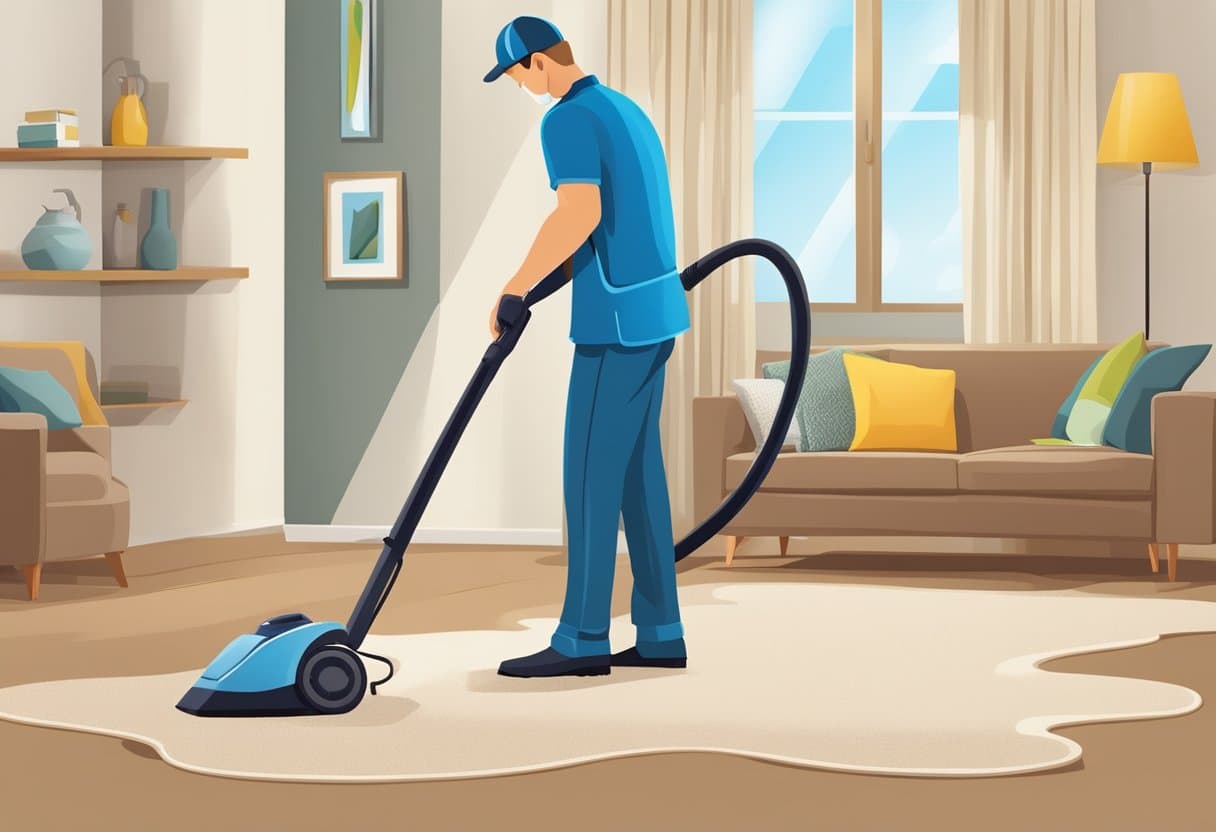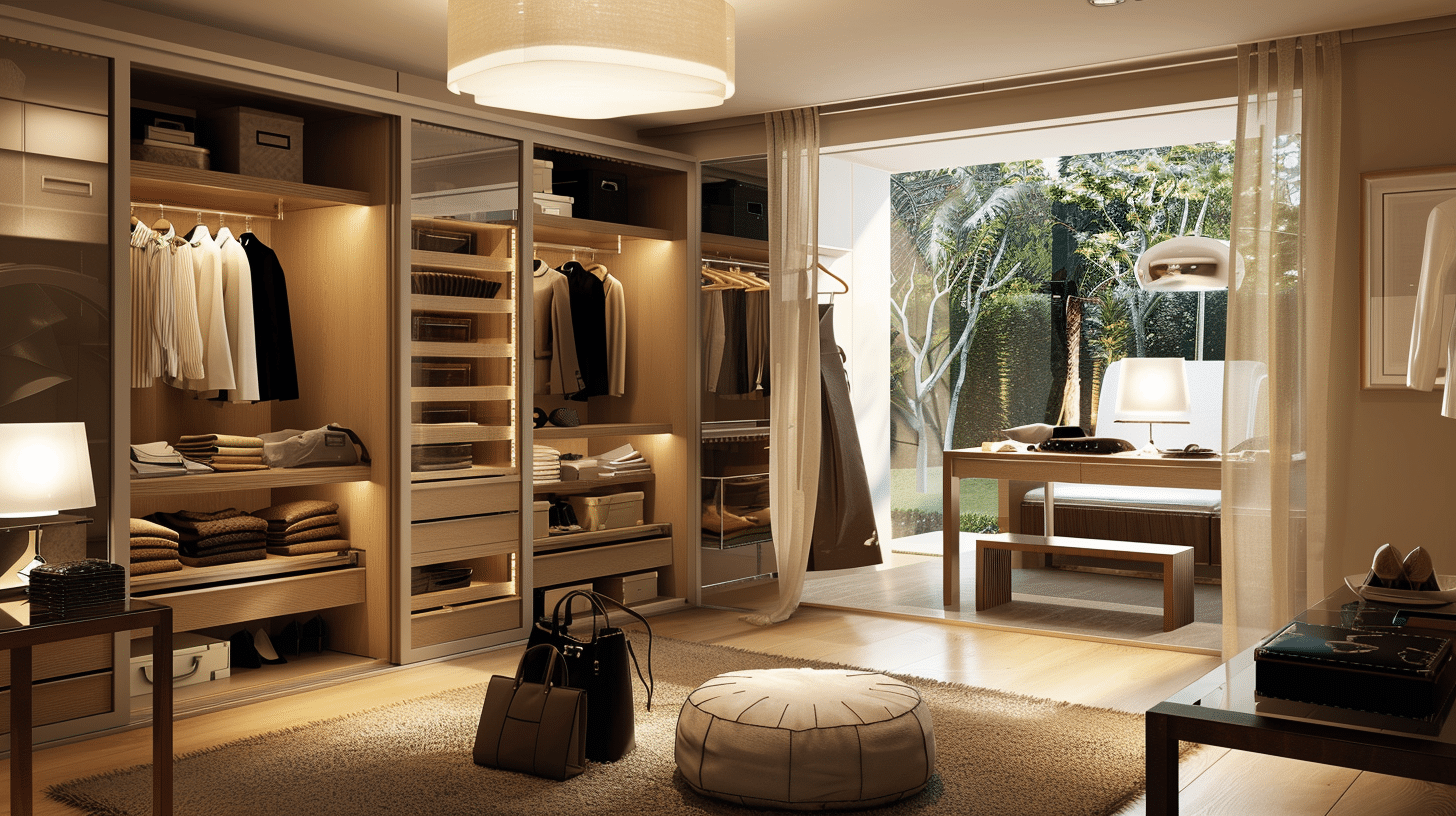Interior Design Tips for a Stylish Home Office
Your home office can feel drab and uninspiring. The problem is you’ll struggle to stay focused and productive in a space that lacks style.
And you wouldn’t be the only one facing this issue.
Many people find it challenging to create a home office that’s both functional and aesthetically pleasing.
But you can have a home office that instantly boosts your mood. You can have the right space that makes you feel organized, motivated, and ready to tackle your day.
You just need a few strategic interior design tips to get started.
You’re on the right web page to transform your home office into a stylish haven. In this article, we’ll cover:
- Furniture selection
- Natural light maximization
- Choosing color schemes
- Awesome storage solutions
And we’ll help you add your own personal touches strategically. Let’s dive in.
1. Select the Right Furniture for Comfort and Style
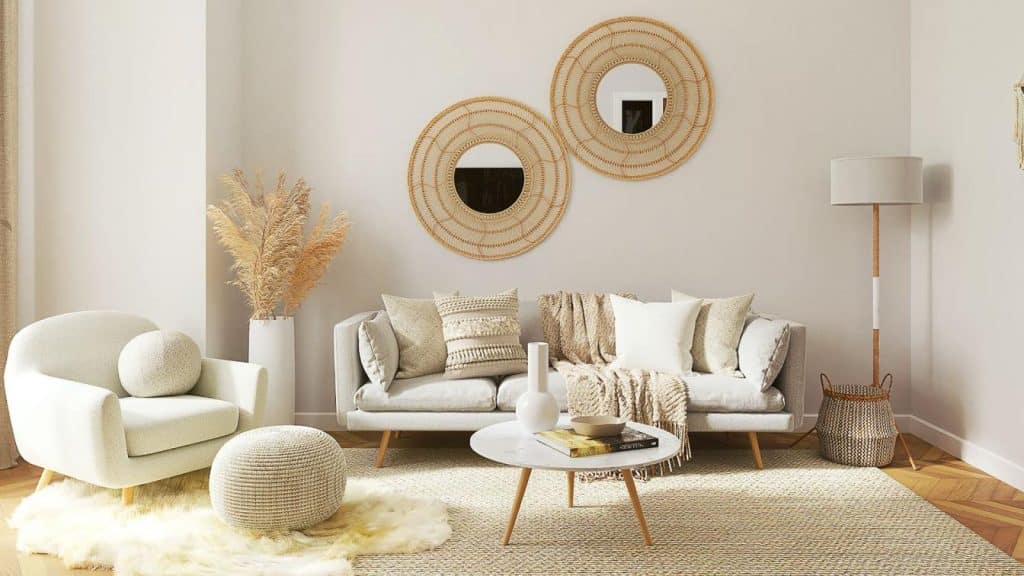
The right pieces can make a significant difference in how you feel and function throughout your workday. Here are some tips to help you balance aesthetics and ergonomics.
Start with the Essentials: The most important piece of furniture in your home office is your desk. Look for a desk that fits your space and meets your needs. Meghan Shouse, assistant editor at House Beautiful adds: “If you have limited space, consider a wall-mounted desk or a compact, multi-functional piece. For larger spaces, we recommend a traditional desk with a large surface area and storage.”
Prioritize Ergonomics: A comfortable office chair is not a whim. An ergonomic chair with adjustable height, lumbar support, and comfortable padding can prevent back pain and improve your posture. If you spend long hours at your desk, you should invest in a high-quality chair to protect your health.
Consider Style: Your furniture should reflect your personal style and complement the rest of your home decor. If you prefer a modern look, you can choose sleek, minimalist pieces with clean lines. If you want the traditional feel, choose classic wooden furniture. If you’re really traditional, consider wooden pieces with intricate details.
Think About Storage: You need efficient storage solutions to keep your office organized and clutter-free. For example, look for desks with built-in drawers or shelves. And add everything else you need – bookcases, filing cabinets, or floating shelves to store documents and supplies neatly.
Incorporate Versatile Pieces: Multi-functional furniture is great for home offices, especially if you’re cramped on space. Think outside the box. Consider a desk that doubles as a dining table or a bookshelf that can also serve as a room divider. All these versatile pieces will save you space and, more importantly, add to the functionality of your office.
Personalize Your Space: You need to add personal touches to make your office feel uniquely yours. A comfortable rug, pictures of that failed trip to Europe, and a few pieces of artwork you like are great starters from that standpoint.
2. Maximize Natural Light for a Bright Workspace

Natural light can transform your home office, making it a brighter and more inviting place to work. Plus, people who work near windows are 56% less likely to experience drowsiness. It’s no wonder 78% of employees say natural light improves their well-being.
So, here’s how to maximize natural light. The point is to create a well-lit workspace that enhances your mood and productivity.
Position Your Desk Wisely: Obviously, you need to place your desk near a window to take full advantage of natural light. But be wise about it. Face your desk towards the window to reduce glare on your computer screen. Plus, you can enjoy the outside view. But if the direct sunlight is too strong, position your desk at a slight angle. This will help you balance light and minimize glare.
Use Light-Colored Furniture and Walls: Light colors reflect natural light, so use them strategically to illuminate your workspace. For example, you can choose white or light-colored walls and furniture. If that’s too much of a chore, add mirrors because they reflect light, so they make the space feel larger and more open.
Opt for Sheer Curtains or Blinds: Heavy curtains can block natural light, meaning your office’ll feel dim and closed off. Instead, use sheer curtains or light-filtering blinds, says Lindsey Lanquist from MyDomaine. These let light pass through while providing some degree of privacy. The point is to enjoy the benefits of natural light without the harshness of direct sunlight.
Keep Windows Clean: Dirty windows obstruct the amount of natural light entering your office. So, clean your windows regularly with the help of cleaning experts. Dust and grime are definite no-nos.
Declutter the Window Area: Never (ever) place large furniture or huge decor items in front of windows. That area must be clear so you get maximum light flow into the room. If you need to place something near a window, opt for low-profile or transparent items that won’t block light.
Incorporate Reflective Surfaces: Reflective surfaces include things like glass, metal, or glossy finishes. These materials are great because they can bounce light around the room. That’s how they enhance its overall brightness.
Bonus points from George Beatty founder of Problem Property Pals: A glass desk, metallic light fixtures, or glossy picture frames also add a touch of elegance.
Add Indoor Plants: Plants make your office look less stressful. And studies agree to that. Office plants increase focus, productivity, and even well-being by 47%. Here’s a pro tip: place your plants near windows to benefit from sunlight. This will improve your workspace feel and contribute to better air quality.
3. Choose Color Schemes That Enhance Productivity
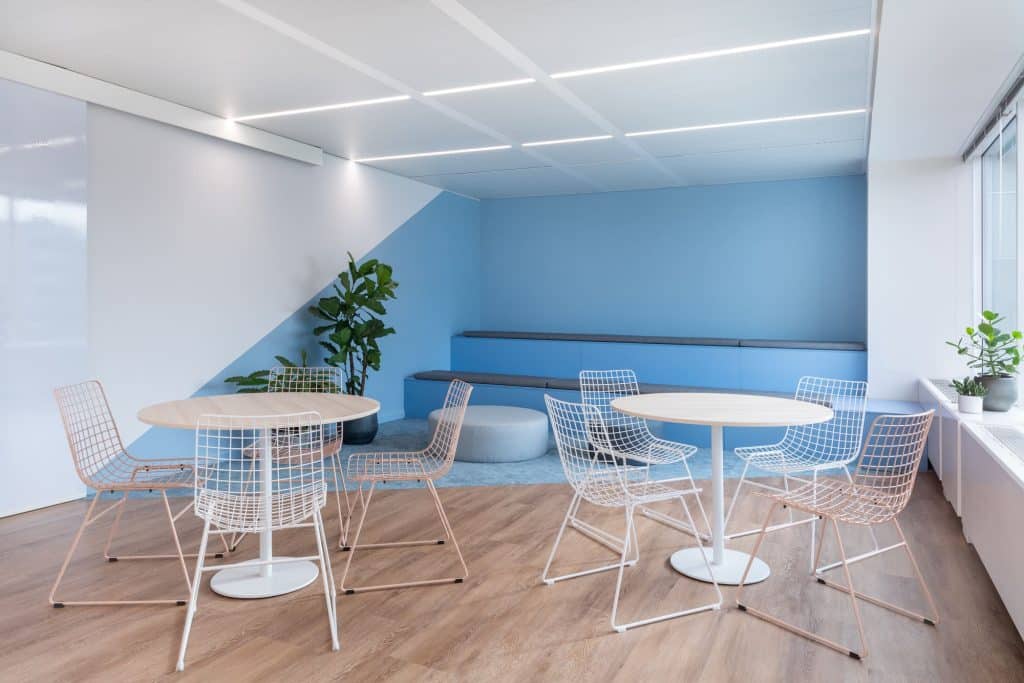
The colors you choose for your home office can have a significant impact on your mood and productivity. For example, one study shows that red can make you feel antsy and stressed, but blue makes you feel depressed.
That’s why you need a well-thought-out color scheme to create an environment that helps you stay focused, calm, and energized.
Here are some actionable tips to pick the best colors for that productive workspace you’re craving.
Understand Color Psychology: Different colors evoke different emotions and reactions. Blue is known for its calming effects and can improve focus and concentration, so it’s a great choice for a home office. However, excess blue can lead to feelings of sadness. Green is another excellent option because it’s easy on the eyes and makes people feel balanced. Yellow has been shown to stimulate creativity and energy but can also lead to overstimulation. So, you should avoid yellow if you have ADHD or if your work doesn’t require creativity.
Experiment with Different Shades: Don’t be afraid to experiment with different shades of the same color. Light blue has a different effect than navy blue. And soft greens create a different atmosphere than deeper forest greens. Test out various shades to find what works best for you.
Consider Neutrals for a Base: Neutral colors include white, beige, or gray for your walls and larger furniture pieces. Neutral colors are great because they give you a clean and calming backdrop. Plus, you get a versatile base that allows you to add pops of color through photos or accessories, tells us Zara O’Hare, interior design consultant at Land of Rugs. And you’ll be able to do it without overwhelming the space. That brings us to the next point.
Incorporate Accent Colors: Once you have your neutral base, incorporate accent colors to accelerate productivity. For example, blue or green accents can promote a calm and focused environment. Use these colors in your desk accessories, artwork, or a feature wall with your goals. Just don’t use a lot of vibrant colors like red or orange as accents. These shades can boost energy and creativity, but too much of them can be distracting.
Balance Warm and Cool Tones: A balanced color scheme combines warm and cool tones. Its main benefit is that you create a harmonious environment. Be creative about it. Warm colors like yellow and red can be mixed with cool colors like blue and green. And it all depends on your tastes. This balance will help you create an energetic yet calming atmosphere.
Personal Preferences Matter: Ultimately, the best color scheme is one you like and feel good with. If certain colors make you feel more comfortable and motivated, use them in your office design. Your workspace should reflect your personality and preferences. That’s how you create a place where you enjoy spending time.
4. Incorporate Storage Solutions to Keep Things Tidy
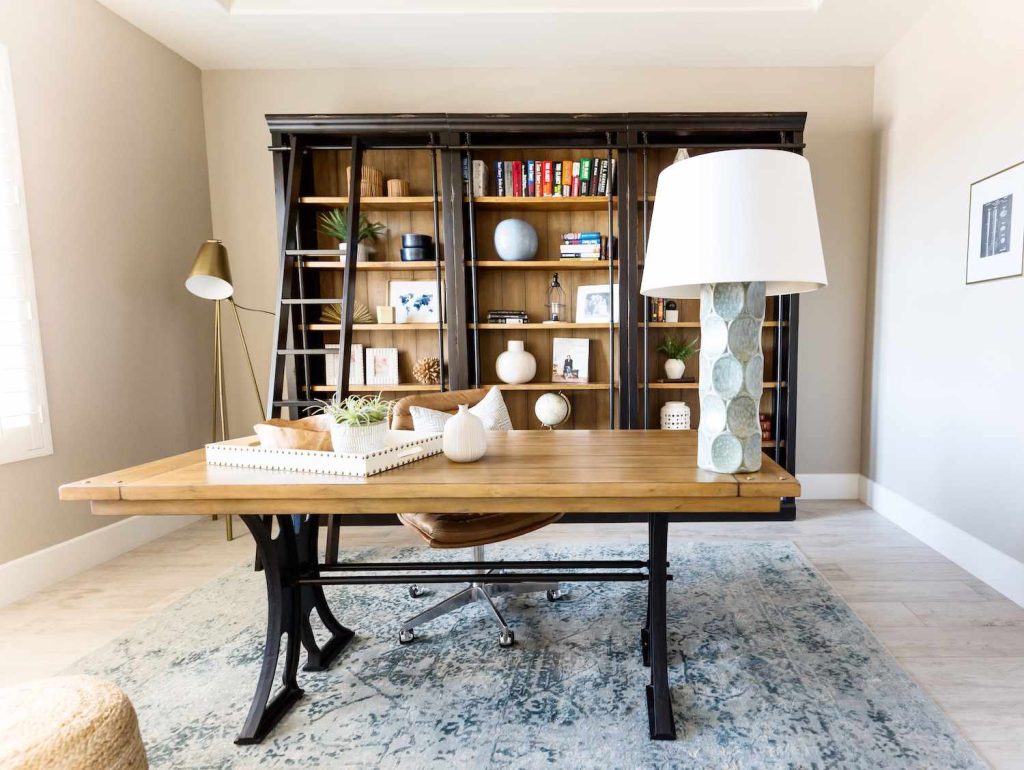
An organized home office is essential for productivity and peace of mind. On the other hand, clutter can be distracting and overwhelming. So it’ll be difficult to focus on work in that kind of environment.
That’s why you need to use smart storage solutions to keep your workspace tidy and efficient.
Here are some effective strategies to organize your home office.
Use Vertical Space: This approach is amazing to maximize your storage. So, here’s what you can do. Install shelves or cabinets on the walls to store books, files, and office supplies. Wall-mounted storage keeps your desk clear and provides easy access to items you need. Another solid option is floating shelves. These are a stylish and functional way to display decorative items.
Choose Multi-Functional Furniture: Invest in furniture pieces that offer built-in storage. Desks with drawers, filing cabinets, or hidden compartments can help you keep your workspace organized. A desk with a hutch can provide additional storage without taking up extra floor space.
Use Storage Bins and Baskets: Storage bins and baskets are great for keeping smaller items organized and out of sight. Label the bins to find what you need quickly. Place baskets on shelves or under your desk. That way, you’ll have easy access to the items you’re using frequently.
Invest in a Filing System: A proper filing system is essential for managing paperwork. Use a filing cabinet or portable file boxes to store important documents. Color-code your files or use labeled tabs to categorize and organize them efficiently.
Consider Modular Storage Solutions: Modular storage solutions allow you to customize your storage to fit your needs. Stackable drawers, cubes, and shelves are awesome because you can arrange them in various configurations to accommodate different items. And you need this flexibility to make sure your storage evolves with your needs.
Keep Cables and Cords Managed: Cables and cords can quickly become tangled and messy. We all know that. But you can use cable organizers, clips, or cable boxes to keep them tidy and out of sight. Even better, label your cables to easily identify which cord belongs to which device.
Incorporate Hidden Storage: Hidden storage solutions are great for that clean and uncluttered look. There’s plenty of furniture with concealed storage compartments, but you can also use decorative boxes that blend with your office decor. This way, you can keep essential items close at hand without adding visual clutter.
Regularly Declutter: Make it a habit to declutter your workspace regularly. Make Mary Kondo proud. So, set aside time each week to tidy up and put things back in their designated places. Regular decluttering is great because that’s how you prevent buildup and ensure that your office remains functional.
5. Add Personal Touches to Make the Space Uniquely Yours

Every self-respecting interior design article will tell you to personalize your home office. The point is always to create a space that reflects your personality and makes you feel comfortable and inspired.
And not have a generic workspace.
But that’s easier said than done for most people.
If you don’t know how to get started, here are some ideas to make your office truly yours.
Display Personal Art and Photos: Surround yourself with images that make you happy and motivated. Hang artwork that you love or display photographs of family, friends, and memorable moments. A gallery wall can add character and warmth to your office. And it’ll serve as a source of inspiration, too.
Incorporate Your Hobbies and Interests: If you love reading, add a cozy reading nook with a comfortable chair and a bookshelf filled with your favorite books. If you enjoy travel, decorate with maps, souvenirs, or photos from your trips. These personal touches make your office feel more like a reflection of who you are.
Use Unique Accessories: Choose office accessories that showcase your style. Opt for a stylish desk lamp, unique bookends, or decorative organizers that stand out. Small details like a custom mouse pad, a colorful desk mat, or a unique pen holder are enough to add a personal touch to your workspace, says Jasen Edwards, chair of the Agent Editor Board at AgentAdvice.
Add Plants and Greenery: We talked about plants above, and we’ll have a separate section in a second. But the point is that bringing nature into your office makes the office feel less stressful. Plus, plants improve air quality.
Customize Your Desk Setup: Arrange your desk according to your workflow and preferences. Personalize your computer background, choose a comfortable chair, and organize your supplies according to your needs.
Include Inspirational Quotes: Decorate your office with quotes or sayings that inspire and motivate you. You can display these on posters, framed prints, or even sticky notes on your bulletin board. Inspirational quotes serve as daily reminders of your goals and aspirations.
Create a Vision Board: A vision board is a powerful tool for visualizing your goals and dreams. Use a corkboard or magnetic board to pin up images, quotes, and reminders of what you want to achieve. This personalized element will keep you focused and motivated.
6. Use Plants and Greenery for a Fresh Atmosphere
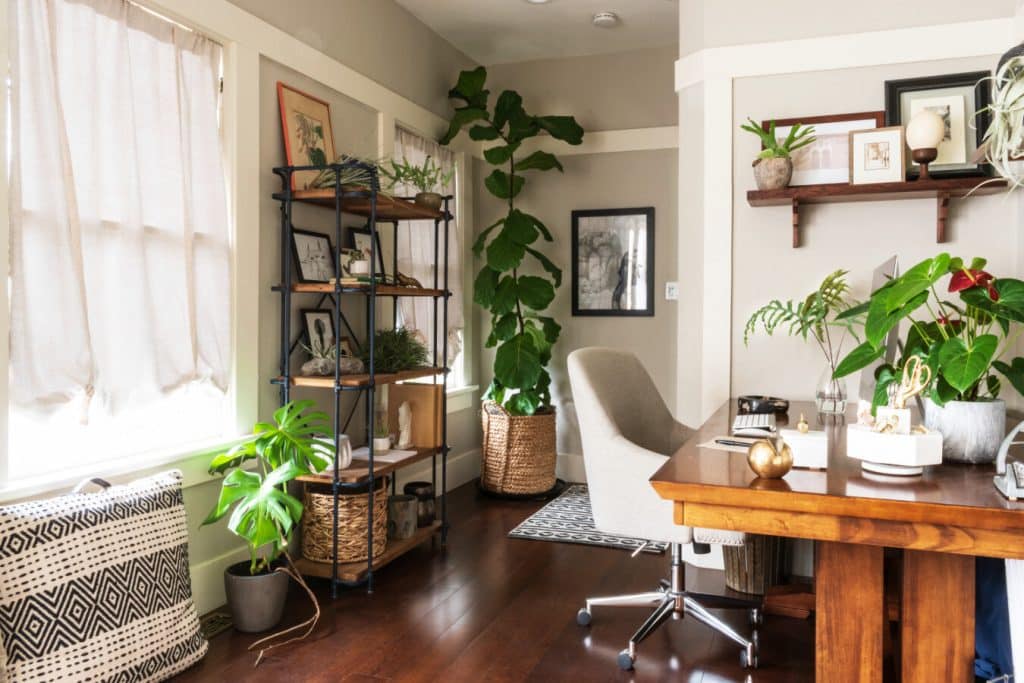
Plants and greenery create a fresh and inviting workspace.
But don’t just start adding plants into your home office. Instead, follow the tips below to make sure you’re leveraging plants correctly.
Choose Low-Maintenance Plants: Select plants that are easy to care for and thrive indoors. Popular options include succulents, snake plants, pothos, and peace lilies. These plants don’t need a lot of attention. Even better, they can tolerate a range of lighting conditions. That’s why they’re so great for busy workspaces. Additionally, for a unique and low-maintenance option, consider indoor synthetic turf to add a splash of green without the upkeep.
Position Plants Strategically: Place plants in areas where they can thrive and improve your office’s aesthetics at the same time. Take this example. A large potted plant in a corner is a bold statement. On the other hand, smaller plants on your desk or shelves are cute and refreshing without taking up too much space. You can also hang plants or use wall-mounted planters to save desk space and create a unique visual appeal.
Enhance Air Quality: Plants are known for their air-purifying qualities. But specific plants like spider plants, aloe vera, and rubber plants especially filter out toxins and improve the overall air quality in your office. This makes your workspace healthier and more pleasant to work in.
Create a Calming Environment: Greenery has a natural calming effect, which can help reduce stress and increase productivity. A small zen garden or a collection of succulents on your desk can provide a peaceful focal point during busy workdays.
Personalize with Planters: Use planters that reflect your style and personality. And the world is your oyster in terms of choices. From modern ceramic pots to rustic terracotta, you have almost infinite options to personalize your workspace.
Rotate and Refresh: To keep your office environment lively, rotate your plants occasionally and introduce new ones. That way, you’ll keep your home office feeling fresh and dynamic. Consider seasonal plants or flowers because they add a touch of color and variety throughout the year.
Create a Mini Indoor Garden: If you have the space, consider creating a mini indoor garden. Use a multi-tiered plant stand to display a variety of plants at different heights. This can serve as a beautiful centerpiece in your office and a constant source of inspiration.
Wrapping Up
In this article, we’ve covered essential interior design tips to help you create a stylish and functional home office. From choosing the right furniture and maximizing natural light to selecting productive color schemes, these tips can transform your workspace.
These step-by-step strategies we discussed offer both aesthetic appeal and practical benefits.
Use them to enhance your productivity and create a pleasant environment to work in. That’s how you can turn your home office into a space you enjoy spending time in.
But remember to consider your specific needs and preferences when making design choices.
With a little planning and creativity, you’ll have a home office that meets your needs and looks great, too.






